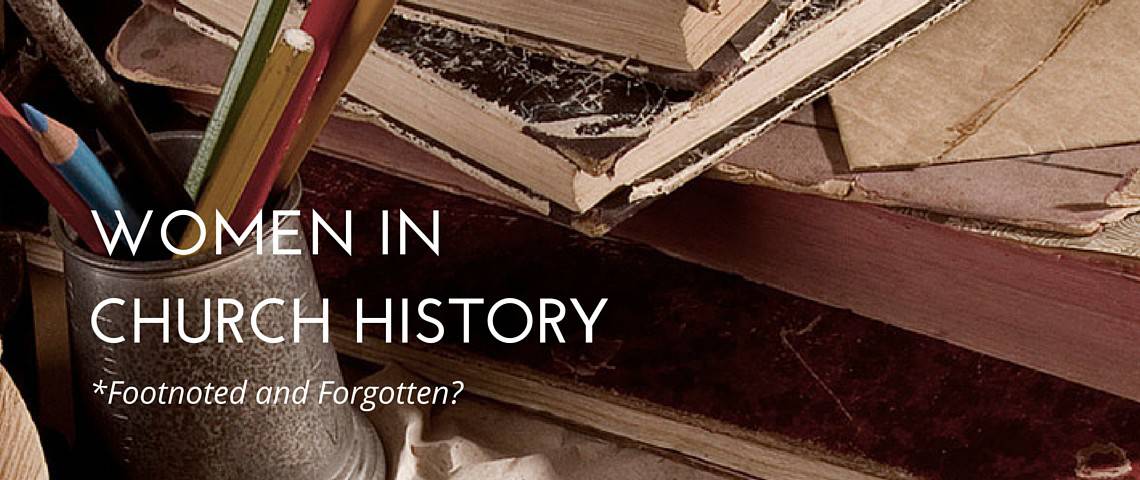
Women have always played a crucial role in the establishment of the Christian church, but their contributions are often footnoted and forgotten. In this post, I examine the role of women in church history who were influential in the early church, medieval Christianity, the Reformation era, and the founding of the American colonies. The goal is to paint a more accurate picture of Christianity which will benefit women and men alike.
Women in Early Church History
In both Jewish and Greco-Roman culture, women did not always have equal access or rights in the public sphere, thus the home was the most socially acceptable and encouraged place for women to speak, teach, and take responsibility. It is within this household context that the Church was raised into infancy.
House churches, the primary channels for the sustainability of the early Church, were funded and led by women such as Lydia (Acts 16:11-40), Nympha (Col. 4:15) and Mary, the mother of John Mark (Acts 12:12). In 1 Thess. 5:12 Paul suggests that such house-church leaders had significant authority as he tells his readers to be thankful for those who “have charge of you in the Lord.”
As the Church acquired legal status in Roman society, it became increasingly subject to the patriarchal ideology of the dominate culture. No longer raising the Church in their homes, women were increasingly marginalized–even banned from church grounds if they happened to be menstruating (HS. 16). As the Church adopted more hierarchal structures in the 4th century, the positions at the top became only open to men, as female bishops or presbyters would have been antithetical to Roman gender ideology (HS. 27).
No longer commonly recognized as ministry partners (Romans 16; Phil 4:2) apostles, (Romans 16:7) and prophets (Acts 21:9; Rev. 2:20), women looked for other roles to fulfill. As MacHaffie notes, “historians generally agree that women had a decisive part in the creation of the church and played a more prominent role in the first generation of Christianity than they did in later centuries” (HS. 4).
Click here to read about early church leaders Perpetua, Proba, and Egeria.
Women in Medieval Christianity
According to the small handful of literate monks, bishops, and noblemen in the middle ages, the status of women in medieval Christianity was a polarizing issue. MacHaffie notes that women were “denounced in strong terms as wicked and inferior”, leading to witch-hunts throughout the fifteenth to eighteenth centuries (HS. 49). Women were also praised and idolized as symbols of the Virgin Mary, an ideal preserved for us in the well-known tales of medieval chivalry (HS. 49).
In the fifth century, monasticism gave women the freedom to travel, become missionaries, and even get involved politically (HS. 54). Yet, moving into the eleventh and twelfth centuries most women’s monasteries were closed and many women leaders left to join bands of traveling communities such as the Beguines. Another option was to live the ascetic life; which offered communal safety to cross borders, avoidance of the physical dangers of childbearing prevalent in this era, and authority by virtue of holiness and personal piety (HS. 57). Vowing the ascetic life also allowed women (as well as men) access to education and the ability to study scripture in a time when literacy rates were low.
Abbesses (monasteries for women) were an important part of medieval Christianity. Understanding the term “ordination” in its original use (sometimes used to describe the consecration of an abbess) women like St. Paula (357-404 C.E.) the sister of Augustine stand out in history as examples of “ordained women” (HS. 58). Beyond her relationship with Jerome, St. Paula established both a monastery and convent throughout her pilgrimage to the Holy Land.
Female mystics are one of the most interesting groups in this period. Between 1100 and 1450, medieval women were a significant part of the Christian mystic tradition. Their work provides us with early writings that make use of bridal imagery for the Church, establishing a precedent for men to claim their rightful identity alongside women as the bride of Christ (HS. 71).
Click here to read about Melania, Christine de Pisan, and Julian of Norwich.
Women in the Reformation Era
The status of women throughout the Protestant Reformation is best understood through the teachings of Martin Luther and John Calvin. With these Protestant champions pushing back on Catholicism’s teachings on marriage, celibacy, and the priesthood, the Reformation’s impact on the domestic life of women was substantial.
Women of the Reformation era exercised their leadership both enclosed by, and breaking through, the walls of patriarchy. For example, according to Luther, as women are the ones responsible for sin entering the world, they are–in their very being–the lesser gender. Calvin, on the other hand, believed the subordination of women stemmed not from sin, but by original creation (HS. 93). On a more positive note, Luther’s (and later Calvin’s) stress on the priesthood of all believers did allow for Protestantism to deconstruct some of the hierarchy between lay Christians and ‘professionalized’ clergy, allowing for a more socially egalitarian Church.
As monasticism was deemphasized, Catholic women increasingly served in the new orders of the Church, leading through the roles of nurses, educators, and caretakers for the poor (HS. 96). Again the pattern surfaces: when women are not allowed leadership in the parish, they move outward into the mission field (e.g. women moving from house church leaders to writers in Rome and moving from Abbesses to wandering mystics in the Middle Ages).
In the early days of the Reformation, Protestant women took on the tasks of preaching and writing; even publishing and distributing books containing reformed doctrine (HS. 99). Yet, as Protestantism flourished and became more institutionalized such roles became increasingly unavailable to women (HS. 99).
Click here to read about Katherine Schutz Zell, Argula von Stauff, and Teresa of Avila.
Women in the American Colonies
At the dawn of American colonization, Puritanism was a dominant religious force and the political and moral standard for American cultural development. The moral vision of the Puritans was so influential that Mark Noll suggests almost all Americans until the 19th century can be seen as reacting to this religious body (HCUS, 40).
While other Christian movements emerged from 17th century America—the Quakers, Baptists, Presbyterians, Anglicans—it is through the literary tradition of the Puritans that most of our knowledge of American women in Church leadership survives.
As the Puritans placed more emphasis on the elements of love, trust, and mutuality, the historical memories of women as evil and easily inclined to sin began to fade. Though women would still be regarded as the “weaker sex”, MacHaffie notices that “Colonial clergymen also began to replace the image of women as inherently evil with the idea that men and women…possess equal opportunities for redemption” (HS, 145).
With the First Great Awakening of American religion (1730s-1740s) as impetus, women in American Christianity were driven by the experience of conversion to transcend prescribed roles and self-understandings. Though Church policy would remain hierarchical, women in the earliest days of America stand as impressive examples that the Spirit works through the marginalized to bring liberation to all.
Click here to read about Anne Hutchinson, Margaret Fell Fox, and Jarena Lee.
Failing to recognize the essential role of women in Church history is to wrongly conclude that we should interpret the Christian story through the broken lens of “he shall rule over her” (Gen. 3:16) rather than humanity’s original commission for partnership (Gen. 2:18).
Rediscovering and reflecting on these contributions of women in church history can help us correct the misconception that the Church was built only on the backs of men.
References
MacHaffie, Barbara J. (2006). Her Story: Women in Christian Tradition (2nd Edition). Fortress Press.
Noll, Mark A. (1992). A History of Christianity in the United States. Eerdmans Publishing.
Pierce, Ronald W., Groothuis, R. M., Fee, G. D. (2005). Discovering Biblical Equality: Complementarity Without Hierarchy. IVP Academic.
More about women in church history
The First Century Church and the Ministry of Women
This overvew was adapted from More than Footnotes:Women in Church. Part 1 – Women in Early Church History, Part 2 – Women in Medieval Christianity, Part 3 – Women in the Reformation Era, Part 4 – Women in the American Colonies. The series was originally posted on Restoring Pangea.
Unheralded and Unknown: Women’s Vital Role in Church History



10 Comments
Michael, as a fellow Fuller student and male church historian, I appreciate your heart for focusing on the great women in church history. I have to admit that as a male, I often wonder to what extent I can write on women in church history. I think that there is a great value to elevating women from all eras of the church, but I worry that some might see us men as “claiming” the heritage of these extraordinary women. Might some women be skeptical about us co-opting the women heroes? Can we as men look on women in church history critically? I hope so, and I have myself enjoyed writing on many of the same women from history that you mention. Such writing can be found here: https://dansalyers.wordpress.com/category/women-in-church-history/
I would love to hear your thoughts, or the thoughts of any other readers from this post on my writings.
Hey Dan, thanks for the thoughtful comment. I really appreciate your humility and the desire to avoid “claiming” the stories of these women in unjust ways. I think the concern you name is important. As a (white) male, I want to write as a partner to women, and so I truly hope that my posture is humble, and teachable. As for me, I wrote about these women mostly out of gratitude. I am incredibly thankful for the ways in which these leaders of the church have shaped the Christian tradition and even my own denomination (e.g. Jarena Lee). I also was dedicated to writing this series because I think forgetting, ignoring, or marginalizing the women who have shaped our history is no small act of injustice.
Certainly, there are more qualified and understanding persons who could help us remember these women–I cite many of them throughout. However, even with the risk of skewing/hijacking the stories of these women through the blind-spots of my maleness, I find it absolutely necessary to contribute in any way toward healing the scars of patriarchy in the story of Christianity and consequently elsewhere. So, in short, I simply see myself as a student and recipient of the work these women have accomplished, and I want myself and others to recognize and remember that gift.
With all of that said, I also hope to see what other readers might say in response to your questions here.
Thanks, Michael. I think that your humble and teachable attitude comes through. I appreciate your thoughts on the idea of men “claiming” women faith heroes. It was just a thought I’ve had in the past, related to my own studies of some harsher postcolonial rhetoric. I echo your sentiment that we need to celebrate women from the past and present and allow them to spiritually form us. Thanks again for responding!
Dan, as a moderator for this blog I can say that most women appreciate it when men help the church recover the stories of these women. I have never viewed that as men claiming our heritage. Did you know that your site is on our recent 49 best blogs post? https://juniaproject.com/49-seriously-good-blogs-christian-egalitarians/
Thanks for the response, Gail! I am glad that men writing about women from church history does not come across that way. Also, thanks for the shout-out on the 49 best blogs post! I am humbled and hope to keep adding new posts and topics to stay on that list!
Michael, I loved your series on women in church history. I’m thankful that you shared it on TJP, otherwise I would have missed it. And thanks for your useful overview here.
Christian men and women today need to realize that gifted women have always been powerful influencers and ministers in the church. We need to be making plenty of room for gifted and capable women to lead.
Love this article, Michael. It’s time we placed women back into our rightful place. Unfortunately, those ignorant of history, will keep pushing their anti-female propoganda, but the more men, like you, raise their voices for equality, the more chances we have of establishing an egalitarian community for the next generation. Thank you!
SUCH A VERY WELCOME HISTORY FROM A MAN! May the Holy Spirit open the hearts of many
other men through this. In the POWERFUL name of Jesus Christ. Amen (SO BE IT)
Love this! Discovering the stories of particular women in church history has been a huge part of relearning my faith.
Another great resource is Handbook of Women Biblical Interpreters, ed Dr. Marion Taylor. Baker Publishing 2012. It’s a collection of short biographies of women (mainly European/American), from the 4th to 20th century.
Thanks for the resource Beth! I’m adding it to my amazon wish list right now 🙂